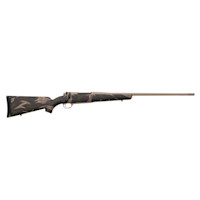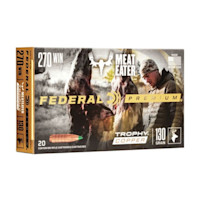
Whenever a new cartridge hits the market, hunters have one question: “How is this better than what we already have?”
That understandable concern is why most wildcat cartridges never make it beyond the basement in which they’re conceived. Hunters already enjoy a stable of effective, widely available cartridges, and they don’t adopt something new just because it’s advertised in a slick marketing campaign.
The 6.8 Winchester Western is the subject of the industry’s latest campaign, and we have a question of our own: Will Winchester’s new offering walk the path of the 6.5 Creedmoor or be the next flash in the pan?
To help us answer that question, we’re pitting the 6.8 against another Winchester cartridge, the venerable old .270 Win. The .270 is among the world’s most successful cartridges, and if Winchester’s newest offering can compete, it stands a good chance of being with us for years to come.
Ballistics The concept behind the 6.8 Western is simple. Rather than go for more cartridge capacity, speed, and power, Winchester’s 6.8 uses long, heavy, high-ballistic coefficient bullets to maintain velocity at extended ranges. It does all this while maintaining a short-action profile and measuring only 2.995" in length.
The 6.8 Western is based on the .270 Winchester Super Magnum but is .085 inches shorter than its parent case. But while the .270 Win. maxes out at bullets weighing about 140 grains, the 6.8 Western can fire projectiles weighing up to 175 grains. That added weight, combined with high BC bullets, gives the Western a theoretical advantage over previous .270-caliber cartridges, especially at longer ranges.
Federal’s highest BC .270, for example, is this 140-grain Berger Hybrid Hunter that clocks in at G1 0.528. Federal offers two 150-grain options in .270, but the BC on those projectiles is only 0.261.
That Berger projectile rivals the BC of Winchester’s new 170-grain 6.8 Western load (G1 0.563), but the .270 Win. is 30 grains lighter and travels at almost exactly the same speed. The 6.8 Western clocks in at 2920 fps at the muzzle and produces 3218 foot-pounds (ft.-lbs.) of energy while the .270 travels at 2950 fps and produces 2705 ft.-lbs. of energy.
If you’re a regular Caliber Battle reader, you know that in many cases, a cartridge that can fire a heavy bullet loses its advantage at longer distances. Not in this case. The 6.8’s high BC bullets capitalize on this advantage to maintain its performance gap at long range.
Using the examples above, the .270 produces 1401 ft.-lbs. of energy at 500 yards while the 6.8 Western hits with 1736 ft.-lbs. The cartridges have virtually identical trajectories, but the 6.8 is landing with about 300 additional ft.-lbs. behind it.
Real-world data doesn’t always match ballistic information published by ammunition companies, but this initial info suggests that ballistically speaking, the 6.8 Western edges out the older Winchester.
Winner: 6.8 Western
Shootability The winner of this category is determined by combining recoil data with the cost and availability of ammunition.
The 6.8 Western is so new that, as far as we know, independent testers haven’t had a chance to determine recoil impulse. But according to Winchester, the 165-grain 6.8 cartridge produces 24.5 ft.-lbs. of energy while the 175-grain produces 23.9 ft.-lbs.
The company does not report the weight of the rifles used in testing, but if they used rifles weighing eight pounds or less, the .270 wins the recoil battle: Chuck Hawks reports that a 150-grain .270 load produces only 17 ft.-lbs. of energy using an eight-pound rifle.
The 6.8 might have less recoil than the .300 Win. Mag. or the .300 WSM, but the laws of physics don’t allow it to produce more power than the .270 without hitting shoulders a little harder. Still, the fact that it so outperforms the .270 ballistically speaking while only imparting marginally more recoil is noteworthy.
In the cost and availability category, the .270 is the obvious winner. The old Winchester cartridge has a 100-year head start, and that advantage is especially apparent in the current ammo shortage.
Midway USA, one of the largest ammunition dealers in the country, offers 68 .270 Win. options, four of which are available as of this writing. The 6.8 Western can be had in five varieties, none of which are available.
Winner: .270 Winchester
Versatility The 6.8’s versatility comes by way of its long-range/short-range capability. It hits with enough power to take virtually any North American big game animal at short range but retains that power to take animals at long range as well.
In terms of raw versatility, however, the .270 is the obvious winner. Manufacturers might add a greater range of bullet weights to the 6.8 in the future, but right now, the Western is only available in the 162 to 175-grain range.
On the other hand, Federal offers the .270 with bullets ranging from 130 to 150 grains, and Terminal Ballistics Research reports that the .270 Win. is sufficient for “almost any hunting situation.” The .270 can be a varmint gun and a big game gun, and it’s been doing great work at long ranges out West for decades.
The versatility of available rifles matches the versatility of ammunition. This is no fault of the 6.8, of course. It can take years for gun makers to start chambering new cartridges, and if the 6.8 increases in popularity, we’ll see more options.
Winchester and Browning both chamber bolt action rifles in the 6.8 Western, and it wouldn’t surprise us to see it adopted into the AR-15 platform. But right now, the .270 is, again, the clear winner. Virtually every rifle manufacturer offers a .270, and it can be found in bolt, semi-auto, and lever guns.
Winner: .270 Winchester
And the Winner Is… Right now, the .270 Win. is the overall winner. It doesn’t offer as much ballistically, but Caliber Battles consider more than raw ballistics. We also consider whether a hunter can find rifles and ammunition, which disqualifies the 6.8 Western from serious contention. A wunderkind cartridge doesn’t do you much good if you can’t find a rifle to shoot it or rounds to practice.
However, we can easily imagine a day in which the 6.8 Western could overtake its older cousin. It offers excellent power at extended ranges without significantly increasing recoil, and it takes advantage of the most cutting-edge bullet technology. Plus, since it can be used in a short action, manufacturers can offer lightweight mountain hunting guns.
There’s a lot to love about the 6.8 Western, but at this point, its ballistic advantage isn’t enough to propel it past the .270. Declaring the winner is an easy call right now, but check back with us in a couple of decades.
Overall Winner: .270 Winchester





